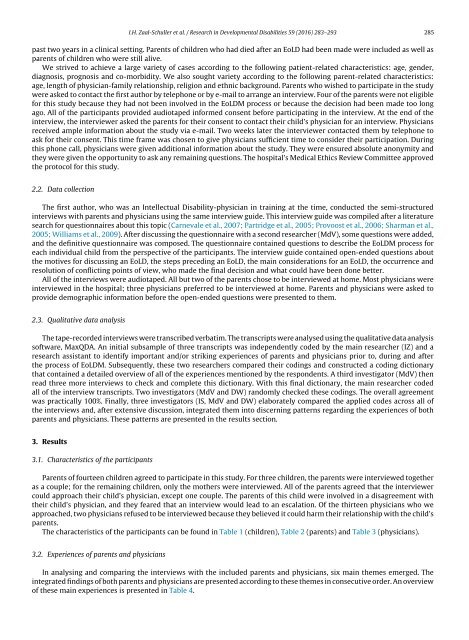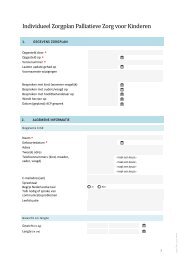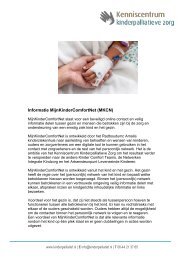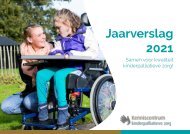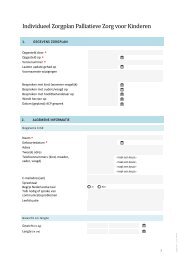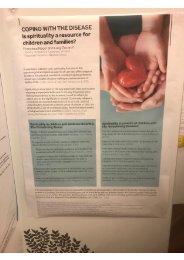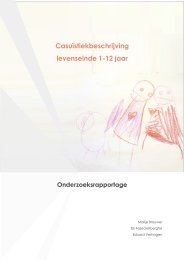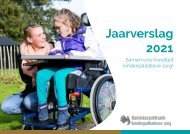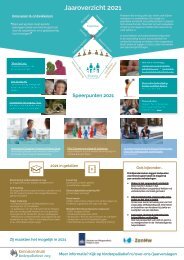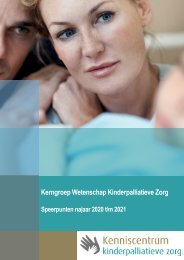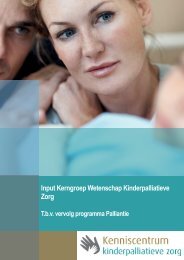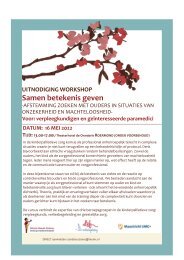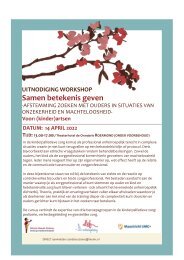How parents and physicians experience end-of-life decision-making for children with profound intellectual and multiple disabilities
Create successful ePaper yourself
Turn your PDF publications into a flip-book with our unique Google optimized e-Paper software.
I.H. Zaal-Schuller et al. / Research in Developmental Disabilities 59 (2016) 283–293 285<br />
past two years in a clinical setting. Parents <strong>of</strong> <strong>children</strong> who had died after an EoLD had been made were included as well as<br />
<strong>parents</strong> <strong>of</strong> <strong>children</strong> who were still alive.<br />
We strived to achieve a large variety <strong>of</strong> cases according to the following patient-related characteristics: age, g<strong>end</strong>er,<br />
diagnosis, prognosis <strong>and</strong> co-morbidity. We also sought variety according to the following parent-related characteristics:<br />
age, length <strong>of</strong> physician-family relationship, religion <strong>and</strong> ethnic background. Parents who wished to participate in the study<br />
were asked to contact the first author by telephone or by e-mail to arrange an interview. Four <strong>of</strong> the <strong>parents</strong> were not eligible<br />
<strong>for</strong> this study because they had not been involved in the EoLDM process or because the <strong>decision</strong> had been made too long<br />
ago. All <strong>of</strong> the participants provided audiotaped in<strong>for</strong>med consent be<strong>for</strong>e participating in the interview. At the <strong>end</strong> <strong>of</strong> the<br />
interview, the interviewer asked the <strong>parents</strong> <strong>for</strong> their consent to contact their child’s physician <strong>for</strong> an interview. Physicians<br />
received ample in<strong>for</strong>mation about the study via e-mail. Two weeks later the interviewer contacted them by telephone to<br />
ask <strong>for</strong> their consent. This time frame was chosen to give <strong>physicians</strong> sufficient time to consider their participation. During<br />
this phone call, <strong>physicians</strong> were given additional in<strong>for</strong>mation about the study. They were ensured absolute anonymity <strong>and</strong><br />
they were given the opportunity to ask any remaining questions. The hospital’s Medical Ethics Review Committee approved<br />
the protocol <strong>for</strong> this study.<br />
2.2. Data collection<br />
The first author, who was an Intellectual Disability-physician in training at the time, conducted the semi-structured<br />
interviews <strong>with</strong> <strong>parents</strong> <strong>and</strong> <strong>physicians</strong> using the same interview guide. This interview guide was compiled after a literature<br />
search <strong>for</strong> questionnaires about this topic (Carnevale et al., 2007; Partridge et al., 2005; Provoost et al., 2006; Sharman et al.,<br />
2005; Williams et al., 2009). After discussing the questionnaire <strong>with</strong> a second researcher (MdV), some questions were added,<br />
<strong>and</strong> the definitive questionnaire was composed. The questionnaire contained questions to describe the EoLDM process <strong>for</strong><br />
each individual child from the perspective <strong>of</strong> the participants. The interview guide contained open-<strong>end</strong>ed questions about<br />
the motives <strong>for</strong> discussing an EoLD, the steps preceding an EoLD, the main considerations <strong>for</strong> an EoLD, the occurrence <strong>and</strong><br />
resolution <strong>of</strong> conflicting points <strong>of</strong> view, who made the final <strong>decision</strong> <strong>and</strong> what could have been done better.<br />
All <strong>of</strong> the interviews were audiotaped. All but two <strong>of</strong> the <strong>parents</strong> chose to be interviewed at home. Most <strong>physicians</strong> were<br />
interviewed in the hospital; three <strong>physicians</strong> preferred to be interviewed at home. Parents <strong>and</strong> <strong>physicians</strong> were asked to<br />
provide demographic in<strong>for</strong>mation be<strong>for</strong>e the open-<strong>end</strong>ed questions were presented to them.<br />
2.3. Qualitative data analysis<br />
The tape-recorded interviews were transcribed verbatim. The transcripts were analysed using the qualitative data analysis<br />
s<strong>of</strong>tware, MaxQDA. An initial subsample <strong>of</strong> three transcripts was indep<strong>end</strong>ently coded by the main researcher (IZ) <strong>and</strong> a<br />
research assistant to identify important <strong>and</strong>/or striking <strong>experience</strong>s <strong>of</strong> <strong>parents</strong> <strong>and</strong> <strong>physicians</strong> prior to, during <strong>and</strong> after<br />
the process <strong>of</strong> EoLDM. Subsequently, these two researchers compared their codings <strong>and</strong> constructed a coding dictionary<br />
that contained a detailed overview <strong>of</strong> all <strong>of</strong> the <strong>experience</strong>s mentioned by the respondents. A third investigator (MdV) then<br />
read three more interviews to check <strong>and</strong> complete this dictionary. With this final dictionary, the main researcher coded<br />
all <strong>of</strong> the interview transcripts. Two investigators (MdV <strong>and</strong> DW) r<strong>and</strong>omly checked these codings. The overall agreement<br />
was practically 100%. Finally, three investigators (IS, MdV <strong>and</strong> DW) elaborately compared the applied codes across all <strong>of</strong><br />
the interviews <strong>and</strong>, after extensive discussion, integrated them into discerning patterns regarding the <strong>experience</strong>s <strong>of</strong> both<br />
<strong>parents</strong> <strong>and</strong> <strong>physicians</strong>. These patterns are presented in the results section.<br />
3. Results<br />
3.1. Characteristics <strong>of</strong> the participants<br />
Parents <strong>of</strong> fourteen <strong>children</strong> agreed to participate in this study. For three <strong>children</strong>, the <strong>parents</strong> were interviewed together<br />
as a couple; <strong>for</strong> the remaining <strong>children</strong>, only the mothers were interviewed. All <strong>of</strong> the <strong>parents</strong> agreed that the interviewer<br />
could approach their child’s physician, except one couple. The <strong>parents</strong> <strong>of</strong> this child were involved in a disagreement <strong>with</strong><br />
their child’s physician, <strong>and</strong> they feared that an interview would lead to an escalation. Of the thirteen <strong>physicians</strong> who we<br />
approached, two <strong>physicians</strong> refused to be interviewed because they believed it could harm their relationship <strong>with</strong> the child’s<br />
<strong>parents</strong>.<br />
The characteristics <strong>of</strong> the participants can be found in Table 1 (<strong>children</strong>), Table 2 (<strong>parents</strong>) <strong>and</strong> Table 3 (<strong>physicians</strong>).<br />
3.2. Experiences <strong>of</strong> <strong>parents</strong> <strong>and</strong> <strong>physicians</strong><br />
In analysing <strong>and</strong> comparing the interviews <strong>with</strong> the included <strong>parents</strong> <strong>and</strong> <strong>physicians</strong>, six main themes emerged. The<br />
integrated findings <strong>of</strong> both <strong>parents</strong> <strong>and</strong> <strong>physicians</strong> are presented according to these themes in consecutive order. An overview<br />
<strong>of</strong> these main <strong>experience</strong>s is presented in Table 4.


